Increasing Student Engagement
- 格式:ppt
- 大小:458.00 KB
- 文档页数:22
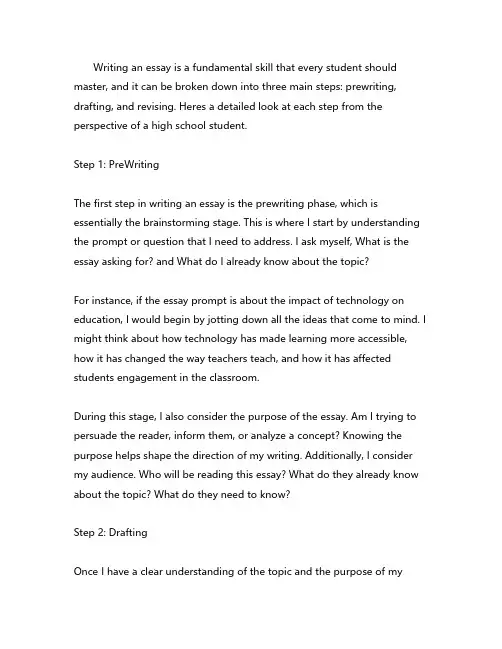
Writing an essay is a fundamental skill that every student should master, and it can be broken down into three main steps: prewriting, drafting, and revising. Heres a detailed look at each step from the perspective of a high school student.Step 1: PreWritingThe first step in writing an essay is the prewriting phase, which is essentially the brainstorming stage. This is where I start by understanding the prompt or question that I need to address. I ask myself, What is the essay asking for? and What do I already know about the topic?For instance, if the essay prompt is about the impact of technology on education, I would begin by jotting down all the ideas that come to mind. I might think about how technology has made learning more accessible, how it has changed the way teachers teach, and how it has affected students engagement in the classroom.During this stage, I also consider the purpose of the essay. Am I trying to persuade the reader, inform them, or analyze a concept? Knowing the purpose helps shape the direction of my writing. Additionally, I consider my audience. Who will be reading this essay? What do they already know about the topic? What do they need to know?Step 2: DraftingOnce I have a clear understanding of the topic and the purpose of myessay, I move on to the drafting phase. This is where I start putting my ideas into a coherent structure. I typically begin with an outline to organize my thoughts.The outline includes an introduction, where I present my thesis statement, which is the main argument or point of the essay. For the technology and education essay, my thesis might be something like, Technology has revolutionized education by enhancing accessibility, transforming teaching methods, and increasing student engagement.Next, I develop the body paragraphs, each focusing on a single point that supports my thesis. I make sure to provide evidence or examples for each point. For example, I might discuss how online learning platforms have made education accessible to people in remote areas or how interactive tools have made learning more engaging for students.In the conclusion, I summarize my main points and restate my thesis, leaving the reader with a clear understanding of my argument. I also consider providing a call to action or a thoughtprovoking question to end the essay on a strong note.Step 3: RevisingThe final step is revising the essay. This is a critical stage where I review my work for clarity, coherence, and correctness. I check for grammatical errors, punctuation mistakes, and spelling issues. I also ensure that my sentences are varied and that my paragraphs flow logically from one to the next.Moreover, I look for ways to improve the essays content. This might involve adding more evidence to support my points, clarifying any vague statements, or even reorganizing paragraphs to enhance the essays structure. I also consider the tone of the essay, making sure its appropriate for the audience and purpose.After revising, I often seek feedback from peers or teachers. Their fresh perspective can help me identify areas that need improvement. I appreciate constructive criticism as it helps me to refine my essay and make it the best it can be.In conclusion, writing an essay is a process that requires careful thought and attention to detail. By following these three stepsprewriting, drafting, and revisingI can create a wellstructured and compelling essay that effectively communicates my ideas. This process not only helps me in academic settings but also enhances my writing skills for future endeavors.。
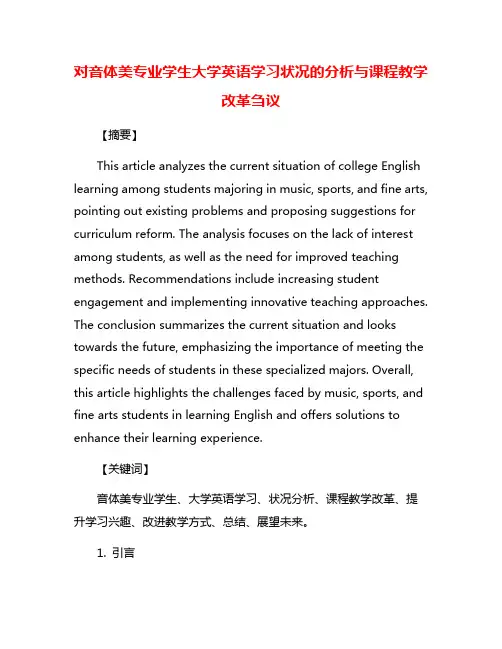
对音体美专业学生大学英语学习状况的分析与课程教学改革刍议【摘要】This article analyzes the current situation of college English learning among students majoring in music, sports, and fine arts, pointing out existing problems and proposing suggestions for curriculum reform. The analysis focuses on the lack of interest among students, as well as the need for improved teaching methods. Recommendations include increasing student engagement and implementing innovative teaching approaches. The conclusion summarizes the current situation and looks towards the future, emphasizing the importance of meeting the specific needs of students in these specialized majors. Overall, this article highlights the challenges faced by music, sports, and fine arts students in learning English and offers solutions to enhance their learning experience.【关键词】音体美专业学生、大学英语学习、状况分析、课程教学改革、提升学习兴趣、改进教学方式、总结、展望未来。
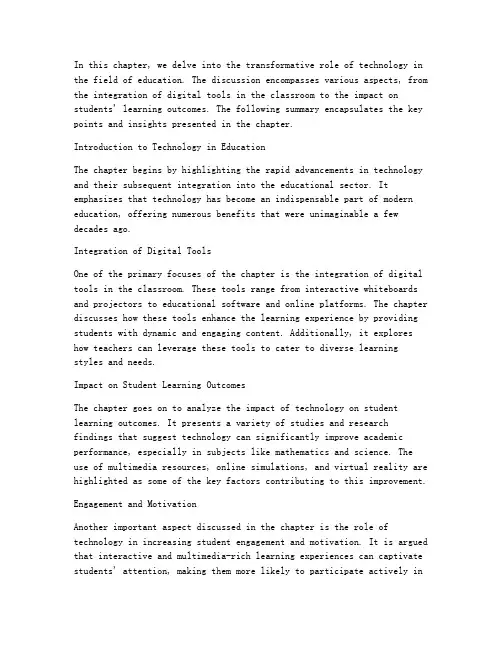
In this chapter, we delve into the transformative role of technology in the field of education. The discussion encompasses various aspects, from the integration of digital tools in the classroom to the impact on students' learning outcomes. The following summary encapsulates the key points and insights presented in the chapter.Introduction to Technology in EducationThe chapter begins by highlighting the rapid advancements in technology and their subsequent integration into the educational sector. It emphasizes that technology has become an indispensable part of modern education, offering numerous benefits that were unimaginable a few decades ago.Integration of Digital ToolsOne of the primary focuses of the chapter is the integration of digital tools in the classroom. These tools range from interactive whiteboards and projectors to educational software and online platforms. The chapter discusses how these tools enhance the learning experience by providing students with dynamic and engaging content. Additionally, it explores how teachers can leverage these tools to cater to diverse learningstyles and needs.Impact on Student Learning OutcomesThe chapter goes on to analyze the impact of technology on student learning outcomes. It presents a variety of studies and researchfindings that suggest technology can significantly improve academic performance, especially in subjects like mathematics and science. The use of multimedia resources, online simulations, and virtual reality are highlighted as some of the key factors contributing to this improvement.Engagement and MotivationAnother important aspect discussed in the chapter is the role of technology in increasing student engagement and motivation. It is argued that interactive and multimedia-rich learning experiences can captivate students' attention, making them more likely to participate actively inthe classroom. Furthermore, the chapter explores how technology can help personalize learning, allowing students to progress at their own pace and focus on areas where they need additional support.Challenges and ConcernsDespite the numerous benefits, the chapter does not shy away from addressing the challenges and concerns associated with the integration of technology in education. Issues such as the digital divide, the potential for distraction, and the need for ongoing professional development for teachers are discussed in detail. The chapter also acknowledges the ethical implications of using technology in educational settings, including privacy concerns and the potential for data misuse.ConclusionIn conclusion, the chapter underscores the pivotal role of technology in shaping the future of education. It highlights the numerous advantages of integrating technology into the classroom, from enhancing learning outcomes to increasing student engagement. However, it also cautions against overlooking the challenges and concerns that come with this integration. The chapter concludes by emphasizing the need for a balanced approach that leverages technology effectively while addressing its potential drawbacks.In summary, this chapter provides a comprehensive overview of the impact of technology in education. It serves as a valuable resource for educators, policymakers, and students alike, offering insights into how technology can be used to create a more effective and engaging learning environment.。
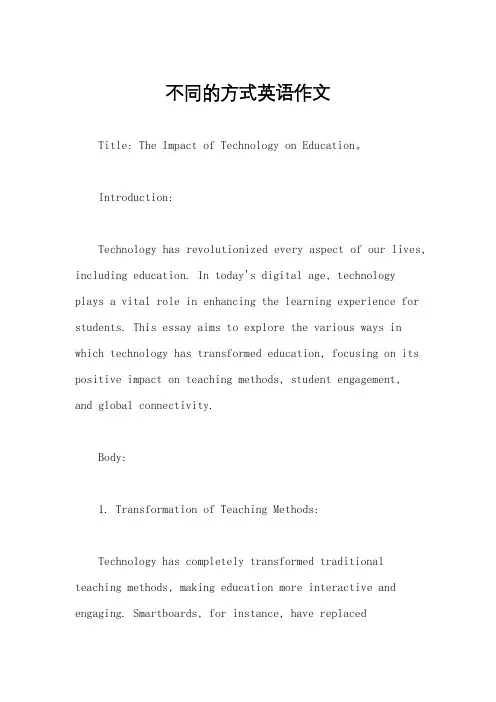
不同的方式英语作文Title: The Impact of Technology on Education。
Introduction:Technology has revolutionized every aspect of our lives, including education. In today's digital age, technology plays a vital role in enhancing the learning experience for students. This essay aims to explore the various ways in which technology has transformed education, focusing on its positive impact on teaching methods, student engagement,and global connectivity.Body:1. Transformation of Teaching Methods:Technology has completely transformed traditional teaching methods, making education more interactive and engaging. Smartboards, for instance, have replacedtraditional blackboards, allowing teachers to incorporate multimedia elements such as videos, images, and interactive presentations into their lessons. This visual and interactive approach stimulates students' interest and enhances their understanding of complex concepts.2. Enhanced Student Engagement:With the integration of technology in education, students are more actively engaged in the learning process. Online platforms and educational apps provide students with personalized learning experiences tailored to their individual needs and learning styles. These platforms offer interactive quizzes, virtual simulations, and gamified learning activities, making the learning process more enjoyable and motivating for students.3. Access to Global Resources:The internet has made it possible for students to access a vast amount of information from around the world. Online libraries, academic journals, and educationalwebsites provide students with a wealth of resources to enhance their understanding and research skills. Thisglobal connectivity allows students to broaden their perspectives and gain insights from different cultures and viewpoints.4. Collaboration and Communication:Technology has also facilitated collaboration and communication among students and teachers. Online platforms, such as Google Classroom and Microsoft Teams, enable students to collaborate on group projects, share resources, and receive feedback from their peers and teachers. This fosters teamwork, critical thinking, and effective communication skills, which are essential for success inthe modern workforce.5. Personalized Learning:Technology enables adaptive learning, where educational software analyzes students' performance and tailors the learning experience to meet their specific needs. Thispersonalized approach helps students learn at their own pace, focusing on areas where they need additional support. Adaptive learning also allows teachers to track students' progress and provide targeted interventions, ensuring that no student is left behind.Conclusion:In conclusion, technology has significantly transformed education, revolutionizing teaching methods, increasing student engagement, connecting students globally, and promoting personalized learning. However, it is important to strike a balance between technology and traditional teaching methods to ensure that students receive a holistic education. As technology continues to advance, its role in education will continue to evolve, shaping the future of learning for generations to come.。
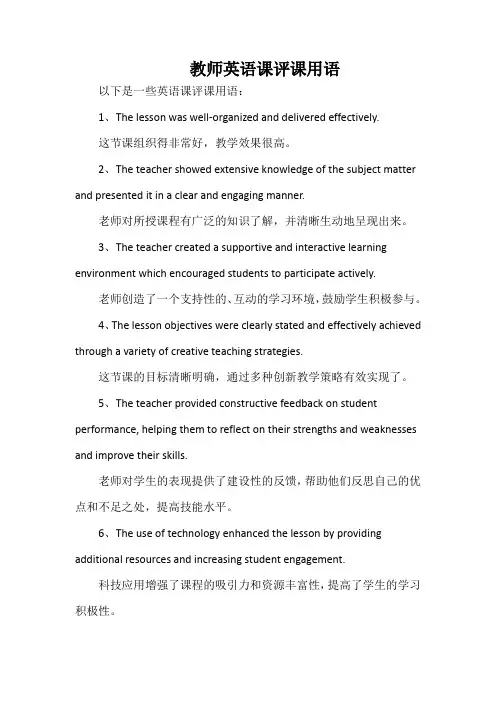
教师英语课评课用语以下是一些英语课评课用语:1、The lesson was well-organized and delivered effectively.这节课组织得非常好,教学效果很高。
2、The teacher showed extensive knowledge of the subject matter and presented it in a clear and engaging manner.老师对所授课程有广泛的知识了解,并清晰生动地呈现出来。
3、The teacher created a supportive and interactive learning environment which encouraged students to participate actively.老师创造了一个支持性的、互动的学习环境,鼓励学生积极参与。
4、The lesson objectives were clearly stated and effectively achieved through a variety of creative teaching strategies.这节课的目标清晰明确,通过多种创新教学策略有效实现了。
5、The teacher provided constructive feedback on student performance, helping them to reflect on their strengths and weaknesses and improve their skills.老师对学生的表现提供了建设性的反馈,帮助他们反思自己的优点和不足之处,提高技能水平。
6、The use of technology enhanced the lesson by providing additional resources and increasing student engagement.科技应用增强了课程的吸引力和资源丰富性,提高了学生的学习积极性。
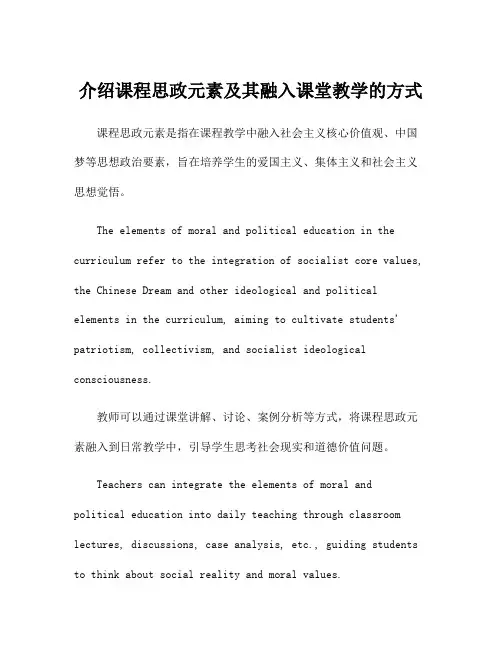
介绍课程思政元素及其融入课堂教学的方式课程思政元素是指在课程教学中融入社会主义核心价值观、中国梦等思想政治要素,旨在培养学生的爱国主义、集体主义和社会主义思想觉悟。
The elements of moral and political education in the curriculum refer to the integration of socialist core values, the Chinese Dream and other ideological and political elements in the curriculum, aiming to cultivate students' patriotism, collectivism, and socialist ideological consciousness.教师可以通过课堂讲解、讨论、案例分析等方式,将课程思政元素融入到日常教学中,引导学生思考社会现实和道德价值问题。
Teachers can integrate the elements of moral andpolitical education into daily teaching through classroom lectures, discussions, case analysis, etc., guiding students to think about social reality and moral values.通过引导学生分析现实案例、进行思辨讨论等活动,增强学生的社会责任感和使命感。
By guiding students to analyze real-life cases, engage in speculative discussions, and other activities, the sense of social responsibility and mission of the students can be enhanced.还可以设计一些相关的课堂活动和作业,让学生通过实际操作和思考,深入理解和接受课程思政元素。
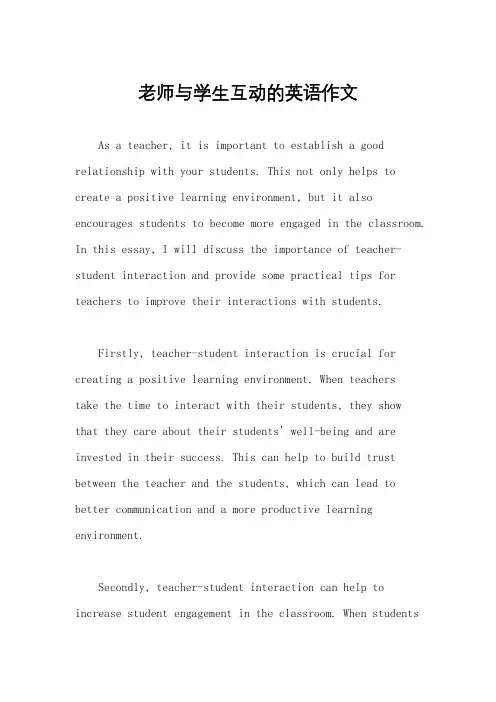
老师与学生互动的英语作文As a teacher, it is important to establish a good relationship with your students. This not only helps to create a positive learning environment, but it also encourages students to become more engaged in the classroom. In this essay, I will discuss the importance of teacher-student interaction and provide some practical tips for teachers to improve their interactions with students.Firstly, teacher-student interaction is crucial for creating a positive learning environment. When teacherstake the time to interact with their students, they showthat they care about their students' well-being and are invested in their success. This can help to build trust between the teacher and the students, which can lead to better communication and a more productive learning environment.Secondly, teacher-student interaction can help to increase student engagement in the classroom. When studentsfeel that their teacher is interested in what they have to say, they are more likely to participate in class discussions and ask questions. This can lead to a deeper understanding of the material and a more enjoyable learning experience for the students.So, how can teachers improve their interactions with students? Here are a few practical tips:1. Get to know your students: Take the time to learn about your students' interests, hobbies, and backgrounds. This can help you to better understand your students and tailor your teaching to their needs.2. Use positive reinforcement: When students do well, be sure to praise them and acknowledge their achievements. This can help to build their confidence and encourage them to continue to do well.3. Encourage student participation: Ask open-ended questions and encourage students to share their thoughts and ideas. This can help to create a more collaborativelearning environment and increase student engagement.4. Provide feedback: Give students feedback on their work and encourage them to ask questions if they need clarification. This can help to improve their understanding of the material and build their confidence.In conclusion, teacher-student interaction is essential for creating a positive learning environment and increasing student engagement. By taking the time to get to know their students, using positive reinforcement, encouraging student participation, and providing feedback, teachers can improve their interactions with students and create a moreeffective learning environment.。
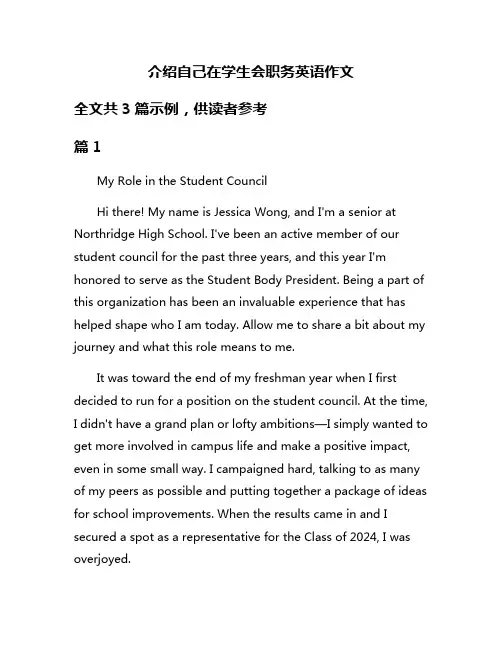
介绍自己在学生会职务英语作文全文共3篇示例,供读者参考篇1My Role in the Student CouncilHi there! My name is Jessica Wong, and I'm a senior at Northridge High School. I've been an active member of our student council for the past three years, and this year I'm honored to serve as the Student Body President. Being a part of this organization has been an invaluable experience that has helped shape who I am today. Allow me to share a bit about my journey and what this role means to me.It was toward the end of my freshman year when I first decided to run for a position on the student council. At the time, I didn't have a grand plan or lofty ambitions—I simply wanted to get more involved in campus life and make a positive impact, even in some small way. I campaigned hard, talking to as many of my peers as possible and putting together a package of ideas for school improvements. When the results came in and I secured a spot as a representative for the Class of 2024, I was overjoyed.Those first few months were a bit of a whirlwind as I settled into my new responsibilities. There was definitely a learning curve when it came to conducting myself professionally in meetings, mapping out initiatives alongside the other council members, and navigating the occasional disagreement. My biggest takeaway from that freshman term was the importance of teamwork and open communication. No one person can drive change alone—it takes a cohesive, well-oiled machine operating together toward a unified goal.Over the next couple of years, I continued serving diligently as a class representative. I helped organize school dances, plan Spirit Week activities, and brainstorm fresh ways to boost school spirit and pride in being a Northridge Knight. With each project, my leadership abilities grew stronger. I became more confident in voicing my ideas, but also more receptive to the perspectives of my peers.When it came time to run for a senior position last year, I knew without a doubt that I wanted to go for the biggest role: Student Body President. I had caught the leadership bug, and I wanted to be a force for positive change during my final year. My campaign focused on three key pillars: promoting inclusivity, amplifying student voices, and leaving a lasting legacy.Becoming President has been one of the most rewarding and illuminating experiences of my life so far. I've had the opportunity to interact with faculty, staff, and administrators in a way that gave me a behind-the-scenes look at how a large school district like ours operates. I've learned how to manage my time efficiently and prioritize tasks based on their importance and impact. Perhaps most valuably, I've grown tremendously in my ability to communicate, negotiate, and find common ground.In this role, I've spearheaded initiatives to increase representation and create a more welcoming environment for students of all backgrounds. We revised the language in our school mission statement and policies to be more inclusive. I worked closely with our Diversity & Inclusion student clubs to elevate their voices and promote cross-cultural understanding through events and awareness campaigns.Another major focus has been making the student council itself more transparent and accessible. We overhauled our social media presence to keep the study body better informed about the latest happenings. I also instituted "office hours" where any student can drop by, share their ideas篇2My Life as the Student Council PresidentAs I sit here reflecting on my high school years, one experience stands out as truly defining - my role as the Student Council President. It was an honor and a privilege to be elected by my peers to represent them and lead our council in strengthening the school community. This essay will give you a glimpse into that journey and what it meant to me.When I first ran for student council in 9th grade, I simply wanted to get more involved and make a positive impact. I had no idea just how transformative the experience would be. As a freshman representative, I learned the ropes of conducting meetings, planning events, and being a voice for my classmates. It was intimidating at first, but the amazing senior leadership guided me every step of the way.By 10th grade, I gained more responsibilities and ran for vice president. That year was a whirlwind of activities - organizing pep rallies, dances, fundraisers, you name it. Managing my time between student council and academics was challenging, but taught me invaluable lessons about prioritization and work ethic.I took pride in bringing our ideas to life and seeing how they positively impacted school spirit.When it came time to run for president my junior year, I had a vision for where I wanted to take our council. My campaign focused on increasing student engagement, giving back to the community through service projects, and leaving a lasting legacy. The election was hard-fought, but the support of my friends, teachers, and family made the difference.My term as president kicked off at our annualbeginning-of-year leadership retreat where we planned out the calendar and formulated goals as a team. I'll never forget the surge of adrenaline and responsibility I felt being officially sworn in. From that point on, I was determined to make it a year to remember.One of my first major initiatives was revamping how we communicated with the student body. We launched social media accounts, installed TV monitors around campus for announcements, and held regular open forums for students to voice any concerns. Just simple efforts to keep everyone in the loop paid huge dividends in participation.Homecoming week was one of the biggest highlights - our committee went all out decorating with the sci-fi theme of "Rangers in Space." Fromållcovering hallways with hand-made planets and spaceships to hosting an intergalactic dance, it tookmonths of hard work but the end result was out of this world! Memories like that bonded our council and the entire student body.Of course, we continued beloved traditions like charity fundraisers, teacher appreciation events, and planning an unforgettable prom. However, I was also driven to shake things up and start some new initiatives. We launched a big brother/big sister program to mentor incoming freshmen during their tricky transition to high school. We also kicked off quarterly community service days where we mobilized volunteers across the city.There were certainly challenges along the way too. Budgeting our funds prudently was an annual struggle. Rallying apathetic students to get involved was an uphill battle sometimes. Dealing with criticism or roadblocks from the administration tried my patience. But these obstacles ultimately made our successes that much sweeter and more rewarding.More than just planning dances and pep rallies, student council pushed me to grow as a leader in public speaking, conflict resolution, creative problem solving and so much more. It groomed me for college and instilled skills I'll carry for life, like communicating with people from all backgrounds and workingas part of a team. Most importantly, it allowed me to pour my heart into improving our school community.My senior year culminated with our monumental legacy project - a total renovation of the student store and surrounding common area. We'd been advocating and fundraising for years to modernize this outdated space into a inviting new hangout lounge. After getting final approval from the principal and school board, we worked tirelessly with contractors and designers to make our vision a reality before graduation. Ribbon cutting ceremony for the grand opening before summer break was one of the most gratifying moments of my life.As I passed the torch to the incoming student leaders at our closing ceremony, it dawned on me what a profoundly meaningful journey this had been. Yes, there were fun times like dances and sporting events, but it went so far beyond that. Student council molded me into a confident, driven person with an enduring passion for bringing people together and contributing positively to the world around me.Those four years flew by in the blink of an eye, yet the experiences, skills, and values I developed will stick with me indefinitely. I'm a better student, leader, and person thanks to my time on the council. It was an unparalleled privilege to representmy peers and create such amazing memories that we'll carry into our bright futures ahead.篇3My Journey in Student LeadershipHey there! My name is Emily, and I'm a senior here at Oakwood High School. Over the past few years, I've had the incredible opportunity to serve as the President of our Student Council. It's been a wild ride, but I wouldn't trade this experience for anything. Let me take you through my journey of how I got here and what it's really been like behind the scenes.If you had told me as a freshman that I'd end up leading the entire student body, I probably would've laughed in your face. I was the shyest kid you'd ever meet back then. Just mustering up the courage to give a presentation in front of my class was a struggle. But I've always been passionate about making a difference, so I decided to take a chance and run for Student Council rep my sophomore year.I'll be honest, that first year was rough. I was a bundle of nerves at every meeting, scared to speak up or share ideas. But my amazing classmates were so welcoming and supportive. Slowly but surely, I found my voice and started suggestinginitiatives to improve things around campus. Whether it was fundraising for new tech in the classrooms or organizing community service events, I loved being part of the positive changes.As junior year rolled around, I realized how much I had grown and decided to run for Student Body President. To my surprise, I won! It was one of the proudest moments of my life. Little did I know, it would also be one of the most challenging. Suddenly, I was responsible for leading meetings, coordinating events, managing conflicts between students and faculty. Talk about a baptism by fire!There was a huge learning curve, and I definitely made some mistakes along the way. But I surrounded myself with an incredible team of officers who helped me every step of the way. We learned so much about effective communication, event planning, budgeting, you name it. Some of my biggest growth came from the challenges we faced.Like the time we planned this massive charity basketball tournament, but severely underestimated how many students would want to play. We had a bit of a scheduling nightmare on our hands! Or when we hosted a battle of the bands concert, andthe audio equipment totally crashed right before the headliner. Situations like that really tested our problem-solving skills.But you know what? We always found a way to make it work. We improvised, motivated each other, and never gave up. I'm so proud of how our team came together during those stressful moments. It's crazy to think about now, but those experiences were also some of the most fun, laughter-filled times I've ever had.Of course, it wasn't all just putting out fires. One of the most rewarding parts of being Student Body President was the chance to amplify student voices. Whether it was advocating for a new club on campus or suggesting curriculum changes to the school board, I loved being a bridge between my peers and the administration.Some of my favorite memories are from the open forums we hosted, where students could raise any concerns and brainstorm solutions together. Hearing such diverse perspectives and trying to find common ground was always so insightful. I got pretty good at healthy debate and conflict resolution, skills that will undoubtedly help me out in the real world.As my senior year starts winding down, I can't help but feel sentimental about this incredible journey. Student leadership hashelped me grow into a confident, driven, and innovative young woman. What once seemed terrifying, like public speaking or managing a team, now feels like second nature. This experience has given me communication, organization, andproblem-solving skills that I'll take with me wherever I go next.More importantly, it's instilled in me a deep passion for advocacy and bringing people together for the greater good. No matter what career path I choose, I know I'll always strive to be a voice for positive change in my community. And I'll forever be grateful to my amazing student council family for giving me the courage and tools to make a difference.To all my fellow students out there, I cannot encourage you enough to get involved with student leadership. It's easy to feel like your voice doesn't matter or you can't create change. But you are so much more powerful than you realize. Take it from me, that shy freshman who never imagined she could inspire others and unite people behind a shared vision. If I can do it, you absolutely can too.So don't be afraid to run for a position or start your own club or organization. Surround yourself with a team you vibe with, and motivate each other to achieve big goals. Trust me, you'll make mistakes and want to pull your hair out sometimes. Butthose are the moments when you'll grow and learn the most. Embrace the challenges, roll with the punches, and never stop believing that you have the power to leave this world better than you found it.To my incredible student council, thank you from the bottom of my heart for taking this wild journey with me. You've become my second family, and the memories we've made will stay with me forever. I have no doubts you'll all go on to create so much positive change.And to my fellow students, keep using your voices and pursuing your passions. This is just the beginning of our adventures as leaders and changemakers. We've got this!。
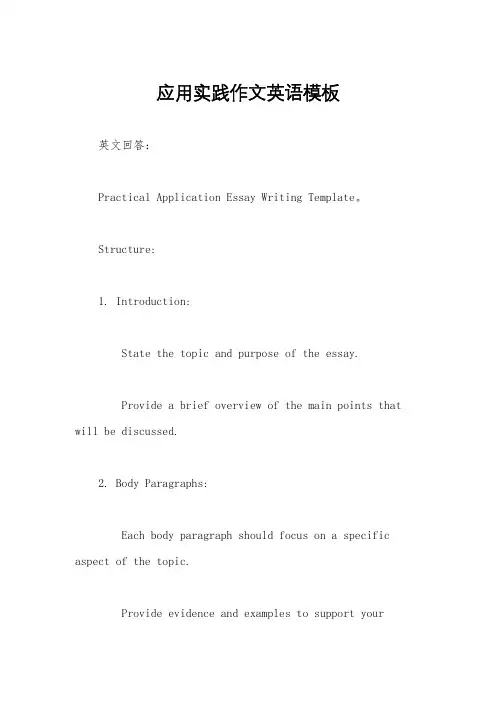
应用实践作文英语模板英文回答:Practical Application Essay Writing Template。
Structure:1. Introduction:State the topic and purpose of the essay.Provide a brief overview of the main points that will be discussed.2. Body Paragraphs:Each body paragraph should focus on a specific aspect of the topic.Provide evidence and examples to support yourarguments.Use logical transitions to connect paragraphs. 3. Conclusion:Summarize the main points of the essay.State your overall conclusion or recommendation. Formatting:Use formal language and academic tone.Times New Roman or Arial font, size 12.Double-spaced lines.1-inch margins on all sides.Content:Focus on practical applications of the topic.Provide specific examples and case studies.Offer evidence-based recommendations or solutions.Consider ethical implications and potential challenges.Example Essay:Topic: The Role of Technology in Enhancing Education。
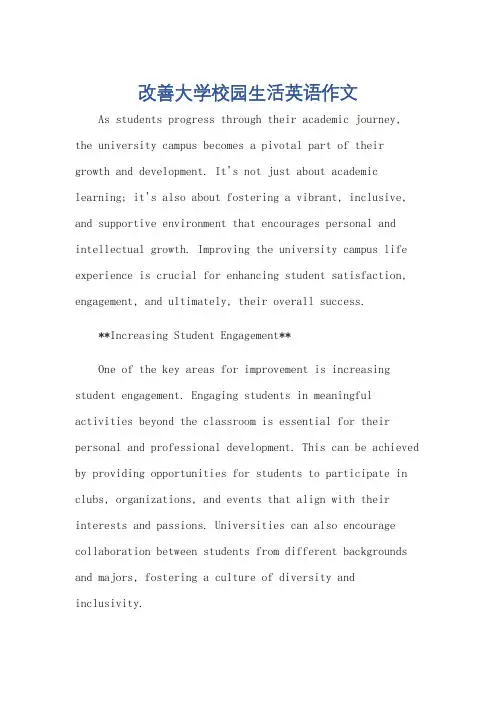
改善大学校园生活英语作文As students progress through their academic journey, the university campus becomes a pivotal part of their growth and development. It's not just about academic learning; it's also about fostering a vibrant, inclusive, and supportive environment that encourages personal and intellectual growth. Improving the university campus life experience is crucial for enhancing student satisfaction, engagement, and ultimately, their overall success.**Increasing Student Engagement**One of the key areas for improvement is increasing student engagement. Engaging students in meaningful activities beyond the classroom is essential for their personal and professional development. This can be achieved by providing opportunities for students to participate in clubs, organizations, and events that align with their interests and passions. Universities can also encourage collaboration between students from different backgrounds and majors, fostering a culture of diversity and inclusivity.**Enhancing Facilities and Amenities**Another important aspect of improving campus life is investing in modern facilities and amenities. This includes providing comfortable learning spaces, state-of-the-art libraries, well-equipped gyms, and healthy food options. By ensuring that students have access to these resources, universities can create an environment that supports their academic and personal pursuits.**Promoting Mental Health and Well-being**In recent years, the importance of mental health and well-being has gained significant attention. Universities should prioritize the mental health of their students by providing access to counseling services, mental health workshops, and peer support groups. By creating a culture of openness and understanding, universities can help students cope with stress, anxiety, and other mental health challenges.**Fostering a Culture of Inclusion and Respect**Inclusion and respect are essential values for any campus community. Universities should strive to create anenvironment that is welcoming to all students, regardless of their background, beliefs, or identity. This can be achieved by promoting inclusive hiring practices, implementing anti-bullying policies, and providing training and education on diversity and inclusivity.**Encouraging Sustainability and Environmental Awareness**As the world faces increasing environmental challenges, it's crucial for universities to instill sustainability and environmental awareness among their students. This can be done by implementing green initiatives, promoting sustainable practices, and encouraging students to participate in environmental conservation efforts.**Conclusion**In conclusion, improving the university campus life experience requires a comprehensive approach that addresses various aspects of student life. By increasing student engagement, enhancing facilities and amenities, promoting mental health and well-being, fostering a culture of inclusion and respect, and encouraging sustainability and environmental awareness, universities can create a vibrantand supportive environment that fosters the personal and intellectual growth of their students.**提升大学校园生活体验**随着学生在学术旅程中的不断进步,大学校园成为他们成长和发展的关键部分。
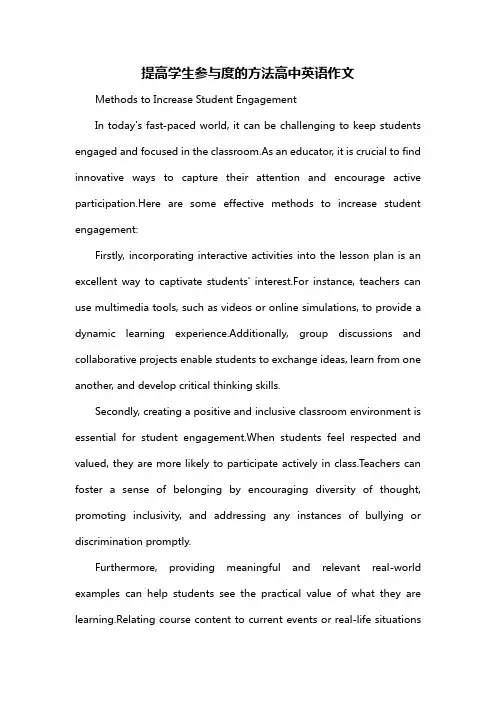
提高学生参与度的方法高中英语作文Methods to Increase Student EngagementIn today's fast-paced world, it can be challenging to keep students engaged and focused in the classroom.As an educator, it is crucial to find innovative ways to capture their attention and encourage active participation.Here are some effective methods to increase student engagement:Firstly, incorporating interactive activities into the lesson plan is an excellent way to captivate students' interest.For instance, teachers can use multimedia tools, such as videos or online simulations, to provide a dynamic learning experience.Additionally, group discussions and collaborative projects enable students to exchange ideas, learn from one another, and develop critical thinking skills.Secondly, creating a positive and inclusive classroom environment is essential for student engagement.When students feel respected and valued, they are more likely to participate actively in class.Teachers can foster a sense of belonging by encouraging diversity of thought, promoting inclusivity, and addressing any instances of bullying or discrimination promptly.Furthermore, providing meaningful and relevant real-world examples can help students see the practical value of what they are learning.Relating course content to current events or real-life situationsnot only makes the subject matter more interesting but also enhances students' ability to apply their knowledge outside of the classroom.Moreover, incorporating formative and summative assessments throughout the course can help track student progress and keep them engaged.These assessments provide opportunities for students to demonstrate their understanding, receive feedback, and reflect on their learning.By incorporating a variety of assessment methods, such as quizzes, presentations, and projects, teachers can cater to different learning styles and encourage active participation.Lastly, using technology effectively can significantly enhance student engagement.Integrating educational apps, online forums, and virtual reality can create an interactive and immersive learning experience.Additionally, technology can facilitate communication and collaboration, allowing students to connect with their peers and educators beyond the classroom.In conclusion, increasing student engagement is a vital aspect of effective teaching.By incorporating interactive activities, creating a positive classroom environment, providing real-world examples, incorporating assessments, and using technology appropriately, educators can foster a love for learning and help students reach their full potential.。
描述能提高你学校生活质量的政策英语作文全文共3篇示例,供读者参考篇1Title: Policies to Improve the Quality of School LifeIntroduction:In order to enhance the quality of school life and promote student well-being, there are several policies that can be implemented in schools. These policies aim to create a supportive and conducive environment for students to learn and grow. In this essay, we will discuss some of these policies and how they can positively impact the overall school experience for students.Policy 1: Mental Health SupportOne of the most important policies that can improve the quality of school life is providing mental health support for students. Schools should have counselors and mental health professionals available to address students' emotional and psychological needs. By providing this support, students can better cope with stress, anxiety, and other mental health issues that may arise during their school years. This policy can helpstudents feel more supported and valued, leading to a more positive school experience.Policy 2: Anti-Bullying PoliciesBullying is a major concern in schools, and it can have a significant impact on students' well-being and academic performance. Schools should have strict anti-bullying policies in place to prevent and address bullying behavior. By creating a safe and inclusive environment, students can feel more secure and comfortable at school. This policy can help foster a sense of community and reduce instances of bullying, leading to a more positive school climate.Policy 3: Healthy Lifestyle PromotionPromoting a healthy lifestyle is another policy that can improve the quality of school life. Schools should encourage students to engage in physical activity, eat nutritious foods, and prioritize their well-being. By instilling healthy habits early on, students can lead healthier and more fulfilling lives. This policy can also help reduce the risk of chronic diseases and improve overall academic performance.Policy 4: Student EngagementStudent engagement is crucial for a positive school experience. Schools should offer a variety of extracurricular activities, clubs, and events to engage students outside of the classroom. By providing opportunities for students to explore their interests and talents, schools can help foster a sense of belonging and community. This policy can also enhance social skills, build confidence, and improve overall well-being.Policy 5: Academic SupportLastly, schools should provide academic support for students who may be struggling academically. This can include tutoring, study groups, and other resources to help students succeed in their academics. By offering this support, schools can ensure that all students have the opportunity to reach their full potential. This policy can also boost confidence, improveself-esteem, and promote a positive attitude towards learning.Conclusion:In conclusion, implementing policies to improve the quality of school life is essential for promoting student well-being and academic success. By providing mental health support,anti-bullying policies, promoting a healthy lifestyle, fostering student engagement, and offering academic support, schools can create a positive and supportive environment for students tothrive. These policies can help enhance the overall school experience, leading to happier, healthier, and more successful students.篇2Title: Policies to Improve the Quality of School LifeIntroduction:As students, we spend a significant portion of our lives in school. Therefore, it is crucial to ensure that our school life is enjoyable, fulfilling, and enriching. The implementation of certain policies can greatly enhance the overall quality of our school experience. In this essay, we will discuss several important policies that can improve the quality of school life.1. Mental Health Support Services:One of the most important aspects of school life is mental health. Students often face various pressures and challenges that can impact their mental well-being. Therefore, schools should provide easy access to mental health support services, such as counseling and therapy. These services can help students cope with stress, anxiety, and other mental health issues, ensuring that they can focus on their studies and overall well-being.2. Anti-bullying Policies:Bullying is a pervasive issue in schools and can have a detrimental impact on students' mental health and academic performance. Schools should implement strict anti-bullying policies and procedures to create a safe and inclusive environment for all students. By fostering a culture of respect and empathy, schools can prevent bullying behaviors and promote positive relationships among students.3. Healthy Eating Initiatives:Nutrition plays a crucial role in students' overall health and well-being. Schools should implement healthy eating initiatives, such as providing nutritious meal options in the cafeteria and offering education on healthy eating habits. By promoting a healthy diet, schools can enhance students' physical health, energy levels, and concentration, leading to improved academic performance.4. Physical Activity Programs:Regular physical activity is essential for students' physical health and mental well-being. Schools should offer a variety of physical activity programs, such as sports teams, fitness classes, and recreational activities. These programs not only promotephysical fitness but also foster teamwork, leadership skills, and self-confidence among students.5. Academic Support Services:Students may face academic challenges at various points in their school journey. Schools should provide academic support services, such as tutoring, study groups, and learning resources, to help students succeed academically. By offering personalized support, schools can empower students to overcome academic obstacles and reach their full potential.6. Student Involvement Opportunities:Student involvement in extracurricular activities, clubs, and leadership roles can greatly enrich the school experience. Schools should provide a diverse range of student involvement opportunities to cater to different interests and talents. By encouraging students to participate in extracurricular activities, schools can foster creativity, leadership skills, and a sense of community among students.Conclusion:In conclusion, the quality of school life can be significantly improved through the implementation of various policies that prioritize students' well-being, academic success, and overalldevelopment. By investing in mental health support services, anti-bullying policies, healthy eating initiatives, physical activity programs, academic support services, and student involvement opportunities, schools can create a positive and enriching environment that nurtures students' growth and success. It is essential for schools to prioritize these policies to ensure that students have a fulfilling and enjoyable school experience.篇3Title: Policies to Improve the Quality of School LifeIntroduction:As students, the quality of our school life greatly influences our overall well-being and academic success. Therefore, it is essential for schools to implement policies that can enhance our school experience and create a positive learning environment. In this essay, we will discuss some policies that can improve the quality of school life.Policy 1: Mental Health Support ServicesOne of the most important policies that can improve the quality of school life is the implementation of mental health support services. Many students face stress, anxiety, and other mental health issues during their time in school, and it isimportant for schools to provide resources and support for these students. By offering counseling services, access to mental health professionals, and promoting mental health awareness, schools can create a supportive and inclusive environment for all students.Policy 2: Student Involvement and EngagementAnother policy that can enhance the quality of school life is increasing student involvement and engagement. This can be achieved through initiatives such as student clubs, sports teams, and extracurricular activities. By providing students with opportunities to engage with their peers and pursue their interests outside of the classroom, schools can promote social connections, personal growth, and a sense of belonging within the school community.Policy 3: Diversity and Inclusion InitiativesCreating a diverse and inclusive school environment is essential for improving the quality of school life. Schools should implement policies that promote diversity, equity, and inclusion, such as cultural awareness programs, diversity trainings for staff and students, and initiatives to support marginalized groups. By fostering a sense of belonging and acceptance for all students,schools can create a welcoming and respectful community that celebrates differences and promotes mutual understanding.Policy 4: Health and Wellness ProgramsPromoting the health and well-being of students is crucial for improving the quality of school life. Schools should offer access to physical fitness programs, nutritious meals, and health education resources to support students' overall wellness. Additionally, initiatives such as mindfulness classes, meditation sessions, and stress management workshops can help students develop healthy coping strategies and improve their mental and emotional well-being.Policy 5: Academic Support and Enrichment OpportunitiesLastly, schools should implement policies that provide academic support and enrichment opportunities for students. This can include tutoring services, study groups, and mentorship programs to help students succeed academically. Additionally, schools can offer opportunities for students to pursue their interests and talents through programs such as advanced placement courses, research projects, and leadership development initiatives.Conclusion:In conclusion, implementing policies that support mental health, student involvement, diversity and inclusion, health and wellness, and academic enrichment can greatly improve the quality of school life for students. By creating a supportive and inclusive environment that promotes well-being, academic success, and personal growth, schools can enhance the overall student experience and foster a positive learning environment. It is essential for schools to prioritize the well-being and success of students by implementing these policies to create a thriving and inclusive school community.。
兴趣对学生的重要性英语作文Interest plays a crucial role in a student's academic journey. It serves as a driving force, fueling motivation and increasing engagement in learning. When a student is genuinely interested in a subject, they are more likely to dedicate time and effort to mastering it, leading to better performance and outcomes. 兴趣在学生的学术之旅中起着至关重要的作用。
它是一种推动力,激发动力,增加学习的参与度。
当一个学生对一个学科真正感兴趣时,他们更有可能投入时间和精力去掌握它,从而导致更好的表现和结果。
Furthermore, having a passion for a particular subject can lead to a deeper understanding and retention of knowledge. When students are enthusiastic about a topic, they are more likely to actively seek out information, ask questions, and engage in discussions, all of which contribute to a richer and more profound learning experience.此外,对特定学科的热情可以导致对知识的更深刻理解和记忆。
当学生对一个主题充满热情时,他们更有可能积极寻找信息,提出问题,并参与讨论,所有这些都有助于更丰富和更深刻的学习经验。
As an English teacher, I have always believed that practical application is the key to mastering a language. Scenario-based teaching, as a modern and effective teaching method, has greatly enriched my teaching experience. In this essay, I will share my reflections on the experience of using scenario-based teaching in English class, highlighting its advantages, challenges, and the impact it has had on both my students and myself.I. IntroductionScenario-based teaching is a teaching approach that integrates real-life situations into the classroom, allowing students to learn and practice English in a more practical and engaging manner. By creating realistic scenarios, teachers can motivate students to actively participate in the learning process, enhancing their language skills and critical thinking abilities. Over the past few months, I have been implementing this method in my English class, and the results have been quite impressive.II. Advantages of Scenario-Based Teaching1. Enhances Practical ApplicationScenario-based teaching emphasizes practical application, which is crucial for language learning. By simulating real-life situations, students can better understand the context in which they need to use English, thus improving their communication skills.2. Increases Student EngagementThe use of scenarios in the classroom can significantly boost student engagement. Real-life situations are more interesting and relatable to students, making them more eager to participate in class activities and discussions.3. Fosters Critical ThinkingScenario-based teaching encourages students to analyze and solve problems in English. This process not only helps them improve their language skills but also enhances their critical thinking abilities.4. Promotes Cultural AwarenessThrough scenarios that involve cultural contexts, students can learn about different cultures and broaden their horizons. This isparticularly beneficial for English language learners, as it helps them appreciate the diversity of the world.III. Challenges of Scenario-Based Teaching1. Time ConsumptionCreating realistic scenarios and preparing related materials can betime-consuming for teachers. It requires careful planning and a deep understanding of the subject matter.2. Teacher's ProficiencyTo effectively implement scenario-based teaching, teachers need to be proficient in English and have a good command of the subject matter.This may be challenging for some teachers, especially those who are not native speakers.3. Classroom ManagementManaging a classroom during scenario-based activities can be challenging. Teachers need to ensure that all students are actively participating and that the activities are running smoothly.IV. Impact on Students and Teachers1. StudentsScenario-based teaching has had a positive impact on my students. They have shown greater enthusiasm for learning English and have made significant progress in their language skills. Moreover, their critical thinking abilities and cultural awareness have also been enhanced.2. TeachersAs a teacher, I have found that scenario-based teaching has helped me improve my teaching skills. It has forced me to be more creative andthink outside the box. Additionally, it has allowed me to gain a deeper understanding of my students' needs and preferences.V. ConclusionIn conclusion, scenario-based teaching is an effective and engaging teaching method that has greatly enriched my teaching experience. Its advantages, such as enhancing practical application, increasing student engagement, fostering critical thinking, and promoting cultural awareness, have made it a valuable tool in my English class. Although there are challenges associated with this method, the benefits it brings to both students and teachers outweigh the drawbacks. As a teacher, I will continue to explore and refine this teaching approach to better serve my students and help them achieve their language learning goals.。
英语教研室4 月工作总结English Department April Work Summary.Introduction.As we draw the curtains on the month of April, it'sonly fitting to pause, reflect, and celebrate the accomplishments of the English Department. This month has been a dynamic and productive one, filled with achievements, challenges, and lessons learned. In this summary, we aim to capture the essence of our work, highlighting the key activities, accomplishments, and future plans.Key Activities.1. Curriculum Development: Our team has been actively engaged in refining and updating the curriculum to alignwith modern teaching methods and student needs. This includes the integration of technology-enhanced learning tools and an emphasis on critical thinking andcommunication skills.2. Teacher Training: We conducted several workshops and training sessions for teachers, focusing on effective teaching techniques, classroom management, and the use of digital resources. These sessions were well-attended and received positive feedback from participants.3. Student Engagement: We organized several engaging and innovative activities for students, including debates, writing competitions, and cultural exchanges. These events not only provided opportunities for students to showcase their talents but also fostered a sense of community and belonging.4. Research and Development: Our research team made significant progress in exploring new areas of English language teaching and learning. This included the development of new teaching materials and the publication of research papers in reputed journals.5. Partnerships and Collaborations: We establishedseveral valuable partnerships with other departments and organizations, aiming to enhance the learning experiencefor our students. These collaborations have resulted in the development of joint courses, exchange programs, and shared resources.Accomplishments.1. Increased Student Engagement: Our student engagement activities have been a resounding success, with a significant increase in participation and enthusiasm from students. This has led to a more vibrant and inclusive learning environment.2. Curriculum Enhancement: The updated curriculum has been well-received by teachers and students alike. The integration of modern teaching methods and technology-enhanced tools has made learning more engaging and effective.3. Teacher Development: Our teacher training sessions have been highly effective in enhancing the skills andknowledge of our teaching staff. This has resulted in improved classroom delivery and a more positive teaching-learning dynamic.4. Research Output: Our research team has made significant contributions to the field of English language teaching and learning, with several papers published in reputed journals and new teaching materials developed.5. Expanded Partnerships: Our collaborations with other departments and organizations have opened up new opportunities for our students, providing them with a broader and more diverse learning experience.Future Plans.1. Continuing Curriculum Development: We plan tofurther refine and update our curriculum, keeping it aligned with the latest trends and student needs.2. Expanding Teacher Training: We aim to expand our teacher training programs, covering a broader range oftopics and attracting more participants.3. Enhancing Student Engagement: We plan to organize more engaging and innovative activities for students, fostering a sense of community and belonging while also developing their language and communication skills.4. Increasing Research Output: Our research team will continue to explore new areas of English language teaching and learning, aiming to make further contributions to the field.5. Strengthening Partnerships: We plan to strengthen our partnerships with other departments and organizations, creating more opportunities for our students to gain practical experience and develop their skills.Conclusion.April has been a month of significant achievements and valuable lessons for the English Department. We are proud of our accomplishments and excited about the opportunitiesthat lie ahead. As we move forward, we remain committed to providing our students with a high-quality, engaging, and transformative learning experience.。
教资作文开拓创新模板英文回答:Education Reform: Embracing Innovation and Creativity。
In today's rapidly evolving world, education has become more crucial than ever before. As the nature of work and knowledge acquisition transforms, it is imperative that we re-evaluate our educational systems to align with the needs of the 21st century. Embracing innovation and creativity is paramount in this endeavor.Innovation in Education:Innovation in education refers to the adoption of novel teaching methods, assessment techniques, and curriculum designs. It entails challenging traditional pedagogical practices and experimenting with new approaches that better engage students and foster deeper learning. This can include incorporating technology, project-based learning,and interdisciplinary connections into the curriculum.Benefits of Innovation:Innovation in education offers numerous benefits, including:Enhanced Student Engagement: Novel approaches can make learning more interactive and enjoyable, increasing student motivation and participation.Improved Learning Outcomes: By tailoring teaching to individual student needs and interests, innovation can promote personalized learning and lead to better academic performance.21st Century Skill Development: Innovation fosters critical thinking, problem-solving, and creativity, which are essential skills for success in the modern workplace.Teacher Empowerment: Innovation empowers teachers to become more effective and adaptable educators, encouragingthem to embrace change and constantly seek ways to improve their practice.Creativity in Education:Creativity in education emphasizes the development of imagination, originality, and divergent thinking. It encourages students to explore multiple perspectives, generate innovative ideas, and express themselves creatively. This can be fostered through art, music, drama, and other creative disciplines.Benefits of Creativity:Fostering creativity in education has several advantages:Problem-Solving: Creative thinking enhances students' ability to generate unique solutions and think outside the box.Innovation: Creativity is a prerequisite forinnovation, as it allows individuals to envision new possibilities and devise novel approaches.Wellbeing: Creative activities promote emotional expression, stress reduction, and overall student well-being.Career Flexibility: In today's rapidly changing job market, creative individuals are highly sought after for their adaptability and ability to generate unique solutions.Conclusion:Innovation and creativity are essential components of21st century education. By embracing these principles, we can transform our educational systems to prepare studentsfor the challenges and opportunities of the future. By fostering a culture of innovation and creativity, we empower our students to become independent thinkers,critical problem-solvers, and lifelong learners.中文回答:教育改革,拥抱创新与创造力。
Enhancing Student Engagement in theClassroomEnhancing student engagement in the classroom is a critical aspect of creating a positive and effective learning environment. It is essential for educators to actively seek out strategies and approaches that will help students feel more connected, motivated, and involved in their learning. There are several perspectives to consider when addressing this issue, including the role of the teacher, the use of technology, the importance of student collaboration, and the impact of the learning environment. One of the most important perspectives to consider when discussing student engagement is the role of the teacher. Educators play a crucial role in creating a positive and stimulating learning environment that encourages active participation and engagement. Teachers can enhance student engagement by incorporating interactive teaching methods, such as group discussions, hands-on activities, and real-world applications of the material being taught. By actively involving students in the learning process, teachers can help them feel more invested in their education and more motivated to participate in class. In addition to the role of the teacher, the use of technology can also significantly impact student engagement in the classroom. With the increasing prevalence of digital devices and online resources, educators have the opportunity to incorporate technology into their teaching to make learning more interactive and engaging for students. For example, using educational apps, multimedia presentations, and online collaboration tools can help students stay more engaged and interested in the material being taught. However, it is important for teachers to strike a balance and ensure that technology is used in a way that enhances, rather than distracts from, the learning experience. Another important perspective to consider is the value of student collaboration in enhancing engagement. Collaborative learning activities, such as group projects, peer teaching, and cooperative problem-solving, can help students feel more connected to their peers and more motivated to participate in class. By working together with their classmates, students can gain valuable communication and teamworkskills while also feeling a sense of belonging and community in the classroom.This can ultimately lead to higher levels of engagement and a more positive learning experience for students. Furthermore, the learning environment itself plays a crucial role in shaping student engagement. A welcoming, inclusive, and supportive classroom environment can significantly impact students' attitudes and behaviors towards learning. Creating a positive learning environment involves not only the physical space, but also the emotional and social atmosphere within the classroom. Teachers can promote a positive learning environment by showing genuine interest in their students, fostering a sense of community and respect, and providing opportunities for students to express themselves and their ideas freely. In conclusion, enhancing student engagement in the classroom requires a multifaceted approach that takes into account the perspectives of the teacher, the use of technology, student collaboration, and the learning environment. Byactively involving students in the learning process, incorporating technology in a meaningful way, promoting collaborative learning, and fostering a positive classroom environment, educators can help students feel more connected, motivated, and engaged in their education. Ultimately, this can lead to improved academic performance, a more positive attitude towards learning, and a greater sense of fulfillment for both students and teachers alike.。